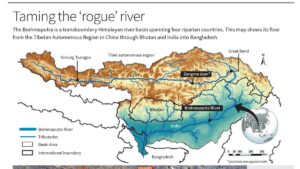China’s Mega-Dam
China has approved the construction of a 60 GW mega-dam on the Brahmaputra River at the Great Bend region in the Medog County of Tibet, which will have significant implications for riparian nations, including India, Bhutan, and Bangladesh. This dam, included in China’s 14th Five-Year Plan, is the largest of its kind in the river basin, intensifying geopolitical concerns and ecological risks in the Himalayan region.
River at the Great Bend region in the Medog County of Tibet, which will have significant implications for riparian nations, including India, Bhutan, and Bangladesh. This dam, included in China’s 14th Five-Year Plan, is the largest of its kind in the river basin, intensifying geopolitical concerns and ecological risks in the Himalayan region.
Key Features of the Brahmaputra and the Dam Project
- Transboundary Nature:
- The Brahmaputra, originating as the Yarlung Zangbo in Tibet, flows through China (upper riparian), India and Bhutan (middle riparians), and Bangladesh (lower riparian) before draining into the Bay of Bengal.
- All riparian nations have major water infrastructure projects planned, including hydropower dams, barrages, and irrigation systems.
- China’s Mega-Dam:
- The dam, located in Medog, aims to harness the river’s immense hydropower potential.
- China has already completed major projects, such as the Three Gorges Dam and Zangmu Dam, establishing its dominance in the region’s water resources.
- India’s Response:
- India plans its largest dam at Upper Siang, reflecting its concerns about China’s unilateral actions on shared watercourses.
- Bhutan is also constructing small to medium-sized dams, raising similar concerns downstream.
Implications of Mega-Dams on the Brahmaputra
- Geopolitical Tensions:
- The Brahmaputra has become a site of strategic rivalry between China and India.
- Lack of binding international treaties, like the UN Convention on the Law of the Non-Navigational Uses of International Watercourses, limits enforceable rights for riparian nations.
- Existing mechanisms like the Expert Level Mechanism (ELM) between India and China, initiated in 2006, remain insufficient for comprehensive governance.
- Impact on Communities:
- Traditional knowledge of the river becomes obsolete due to altered flow patterns and intensified disasters.
- Blocking the river’s flow for hydropower generation could reduce water levels downstream, disrupt monsoons, and deplete groundwater, harming agriculture and livelihoods in India and Bangladesh.
- Climate change exacerbates risks, as seen in events like the 2023 Chungthang Dam collapse in Sikkim, which caused widespread devastation.
- Environmental and Ecological Risks:
- Dams disrupt natural river cycles, threatening biodiversity, agro-pastoral systems, and wetland ecosystems.
- Tibet’s river systems, part of the Earth’s cryosphere, are critical for global climate systems, including monsoons and precipitation pathways.
- The Himalayan region faces increased risks of Glacial Lake Outburst Floods (GLOFs) due to rising temperatures.
Historical and Strategic Context
- Earthquake Risks:
- Medog, the site of China’s dam, was the epicenter of the 1950 Assam-Tibet earthquake, which caused catastrophic floods in downstream regions like Assam and Bangladesh.
- Building mega-dams in seismically active zones adds to the risk of disasters.
- China’s Strategic Motivations:
- In Chinese history, the Yarlung Zangbo is referred to as a “rogue river” due to its sharp turn at the Great Bend before entering India.
- The dam reflects China’s effort to “discipline” the river and assert control over natural resources.
Proposed Solutions
- A bioregional/ecoregional framework emphasizing sustainable and cooperative management of Himalayan rivers could help reduce tensions.
- India can assume a leadership role by promoting regional collaboration rather than engaging in a “dam-for-dam” race with China.
By prioritizing diplomacy and environmental sustainability, the Brahmaputra river basin can avoid becoming a geopolitical and ecological disaster.
MCQs
1. What is the primary purpose of China’s mega-dam at the Great Bend on the Brahmaputra?
A) Control flooding in Tibet and neighboring regions.
B) Harness hydropower and assert strategic dominance.
C) Support irrigation and agriculture in downstream nations.
D) Create a navigable waterway for international trade.
2. Which of the following is a major risk associated with constructing mega-dams on the Brahmaputra river?
A) Increase in navigational routes.
B) Decrease in hydropower potential.
C) Disruption of downstream water levels and ecosystems.
D) Strengthening traditional knowledge systems.














